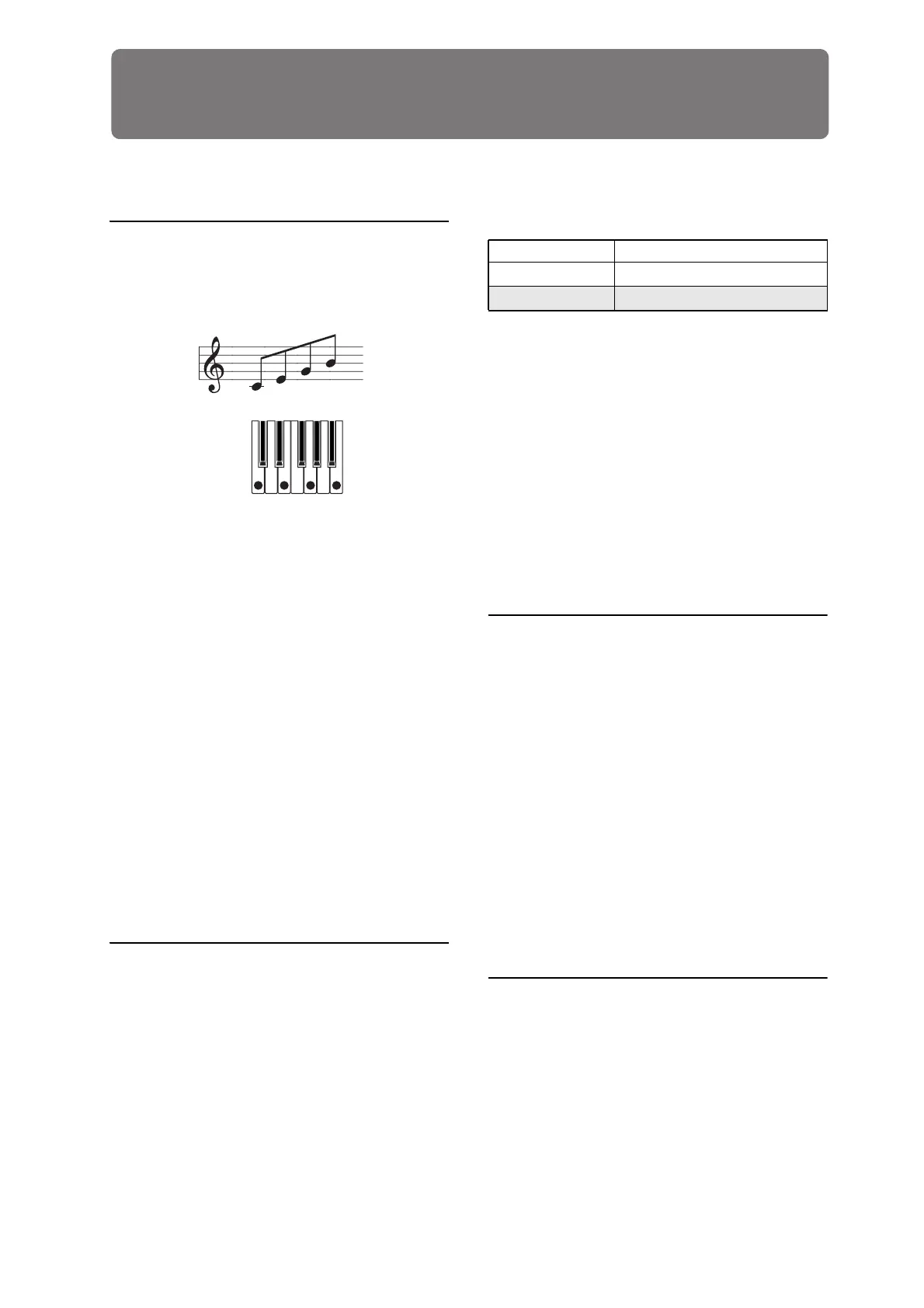157
Arpeggiator function
Arpeggiator functions and scene settings
Arpeggiator function
The arpeggiator is a function that automatically generates
arpeggios (patterns of individual notes derived from a
chord). Most arpeggiators produce an arpeggio when you
play a chord on the keyboard.
The NAUTILUS’s arpeggiator is also polyphonic, and can
produce a variety of chordal transformations or phrases
based on the pitch or timing of the notes you play on the
keyboard. These functions let you use the arpeggiator to play
a wide range of patterns including drum or bass phrases, and
guitar or keyboard backing riffs. It is also effective to use the
arpeggiator as part of the sound-design process when
creating subtly-moving pads, synth-sounds, or sound effects.
The NAUTILUS’s Dual Arpeggiator feature lets you use
two simultaneous arpeggio patterns in COMBINATION
mode, and SEQUENCER mode. You can take advantage of
this in many ways, including a separate arpeggio pattern for
a drum program, and another applied to a bass program, or
using a keyboard split or velocity to switch between two
arpeggio patterns.
Arpeggio Patterns
The NAUTILUS provides five preset arpeggio patterns: the
standard UP, DOWN, ALT1, ALT2, and RANDOM. You
can also create and store 2,176 of your own user patterns.
The factory settings contain a wide variety of arpeggio
patterns stored in these user locations. You can also create
your own user arpeggio patterns. (See “Editing arpeggio
patterns” on page 197.)
Using the Drum Track: overview
What is the Drum Track?
The Drum Track is a built-in drum machine, fueled by the
NAUTILUS’s high-quality drum sounds.
It gives you a beat to play along with as you experiment with
Programs and Combinations, or as you work out the outline
of a song.
There are hundreds of preset Drum Track patterns covering a
wide range of musical styles, and you can also create your
own (as we’ll explore later in this chapter).
Drum Track Pattern contents
You can write to patterns U000 through U999. Patterns that
you create in SEQUENCER mode can be converted into
user Drum Track patterns.
There are options to control how the Drum Track pattern
starts, such as starting immediately when you press the
DRUM button, or waiting until you start to play the
keyboard. If you’re starting the pattern by playing the
keyboard, you have the option of starting it by using a
specific range of notes or velocities.
In PROGRAM mode, the Drum Track has its own mixer
channel (including EQ) and separate effects routing, for
independent control of the sound. In COMBINATION and
SEQUENCER mode, the Drum Track plays normal Timbres
and Tracks, with all the normal controls over Program
selection, EQ, effects routing, and so on.
Step sequencer: overview
The step sequencer function lets you input notes in grid
style to easily create loop patterns (step sequences). By
turning steps on/off you can create step sequences in an
intuitive way, and modify a step sequence while it plays
back.
A step sequence consists of up to 64 steps, and you can add
volume accents and a sense of swing to the steps. A step
sequence can use up to 12 different tones, such as kick or
snare. You can edit the number of steps in a step sequence,
and specify the instrumental sounds (Inst) that will actually
be sounded by the tones.
Each program can have four step sequences. These step
sequences can be selected for each scene, and you can switch
between them when you play.
You can select the sounds used for each tone from the drum
set variation that is currently selected. You can also switch
out the drum sets themselves.
Scene settings: overview
The settings for the arpeggiator and drum track or step
sequence can be saved for each program or combination as
four different scenes.
Scenes that can be played are already set for many of the
preset programs and combinations. You can switch between
scenes to make instant changes to the arpeggiator settings or
to a drum phrase.
A single scene can use an arpeggiator, as well as either a
drum track or step sequencer. You cannot use both a drum
track or step sequencer at the same time.
The chord you played on the
keyboard is sounded as an
arpeggio (broken chord)
Bank Contents
Preset P000…1271 Preset Drum Track patterns
User U000…999 User Drum Track patterns
